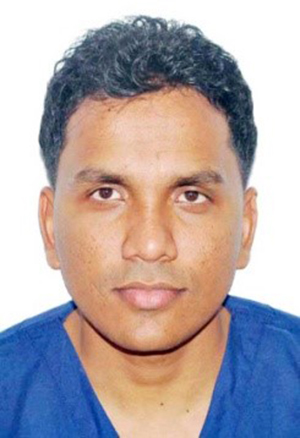Disclosing that 95 persons died from snakebites between 2010 and 2014, the Ministry of Public Health (MoPH) yesterday said it has finalised its protocol for treating snake-bites while simultaneously ensuring that anti-venom treatment is available at certified public sector sites.
This is according to the Chief Medical Officer (CMO) Dr Shamdeo Persaud.
According to a MoPH release, it is also in the process of rolling out the newly-crafted protocols nationwide and making available the necessary paraphernalia for proper management of snakebites. The Ministry is also exploring best practices to monitor the physiological effects of envenomation (the process by which venom is injected into a victim through bite or sting) and its complications. The current management protocols include supporting pain control, tetanus protection, blood transfusion, infection control and wound care for victims.

The CMO also disclosed that this year, the Ministry had purchased anti-venom treatment from Costa Rica which is currently available at the Georgetown Public Hospital (GPHC).
“The Ministry procured separate preparations of anti-venom (PoliVal–ICP anti-venom) and they are available at MoPH sites that have the necessary capacity to administer this treatment. This poly-valiant anti-venom is indicated for use in the common viper (Labaria and Bushmaster) envenomation.” Persaud was quoted as saying.
GPHC currently has the capacity to implement the new protocol. The institution also has the ability to manage possible complications from the use of anti-venom including allergic/anaphylactic reaction, which could be life-threatening. The most common anaphylactic reactions are to foods, insect stings, medications and latex. If one is allergic to a substance, one’s immune system overreacts to the allergen by releasing chemicals that cause allergy symptoms.
In addition, Dr Persaud said the GPHC’s Accident and Emergency Unit is spearheading a training scheme for all relevant staff at regional and district Hospitals nationwide to prevent the over-burdening of the GPHC system.
He disclosed that available statistical and anecdotal evidence suggest that the public health sector must take a more aggressive stance to help curb incidences of life-threatening bites from venomous vipers rampant especially in the country’s heavily-forested interior communities.
Statistics from 2010 to 2014 show that there were 1,190 cases of snakebite resulting in the death of 95 persons. The official five-year figures also show that adult males, followed by adult females, are more vulnerable to the lethal bites from these dangerous reptiles.
As part of the snakebite sensitisation plan, communities will be educated about proper measures to implement to minimise contact with snakes and avoiding their deadly bites; provided with guidance on safety measures to follow if bitten; and participate in capacity-building training for all medical and health professionals on the management of snake bites at public health facilities.
One innovative move, Persaud said, would be to establish a national network of snakebite survivors to help raise awareness and promote safe practices among residents who are vulnerable to these dangerous reptiles.
The Ministry is also seeking the cooperation of all residents in high-risk areas including farms, forested areas, woodlands, grasslands and newly developed housing areas to:
● ensure that possible breeding sites for snakes be reduced by eliminating dumping and heaping of organic and vegetation waste such as branches, weeds, cuttings and coconut shells.
● remove overgrown vegetation that may serve as avenues to residents yards and public waterways by dangerous species of snakes.
● desist from discarding/dumping unused foods and food materials indiscriminately which may attract rats and also snakes (searching for food) to the domestic surroundings;
● use personal protective equipment (PPEs) and observe caution signs when exploring, clearing or venturing into high-risk areas.
Bleeding, neurological complications and extensive tissue necrosis (e.g. gangrene) usually accompany bites from venomous snakes. And because these incidents frequently take place in the country’s heavily-forested interior areas, victims routinely have to be air-dashed to the capital for life-saving treatment, which is always an expensive enterprise.
Coastal victims of bites from venomous serpents are a bit more fortunate in that they can readily get treatment at local health facilities for envenomation, which involves preventing further release of toxins in the victim’s body.
Caution when administering
According to Dr Zulfikar Bux, Head of the Accident and Emergency Unit of the GPHC, doctors must exercise more caution when administering anti-venom to snake-bite patients and must also familiarise themselves about likely side effects.
“The anti-venom is not like regular medication. You have to know about the dosage and how to administer it to the patient because not every single snake bite (is poisonous). It’s the complicated bites…that are more serious [so] you have to anticipate complications because there are some amount of risks of hypersensitivity and severe allergic reaction to the anti-venom,” Dr Bux explained.
Dr Bux, who is also an emergency specialist, was instrumental in helping develop the protocol which guides administering of anti-venom in Guyana. He said the protocol meets the medical requirement and was accepted and approved by the Medical Advisory Committee of the GPHC.
Following the acceptance of the protocol, 20 doctors from the District Hospitals in Pomeroon Supenaam (Region Two); Essequibo Islands/west Demerara (Region Three); and Mahaica/Berbice (Region Five) were trained in implementing the new guidelines to treat snake bites.
“The training was well received by the doctors. We did a pre-test assessment which showed that physicians have limited knowledge in administering the anti-venom. Post-test results following the training showed that their knowledge base increased quite drastically.” Dr Bux said. He added, “Our next step will be to take the team to the hinterland to conduct the training. Once they have been certified as successful, we will distribute the protocol to those hospitals and implement the anti-venom participating medical institutions.”
Guyana’s economy still depends heavily on agriculture and the heavy dependence on farming, logging and mining exposes locals to the risk of contact with venomous snakes. However, the MoPH has pledged to continue year-round collaboration with all stakeholders to help reduce the incidences of snake bites, and when it does occur, to always be in a position to guarantee timely intervention and adept management of victims to save their lives.





